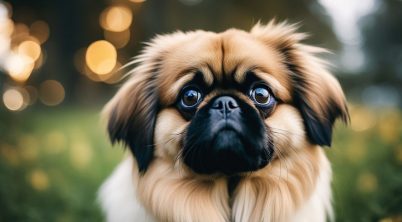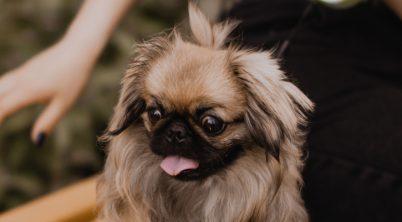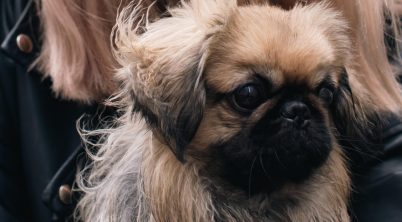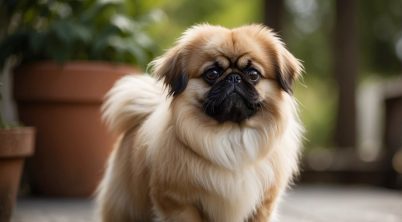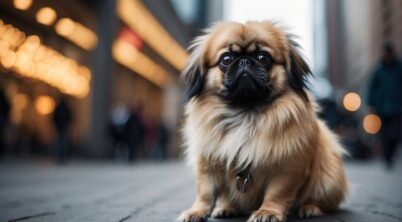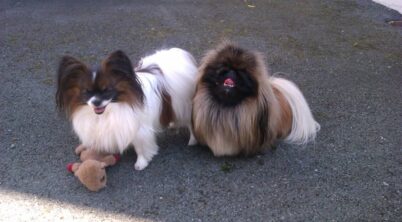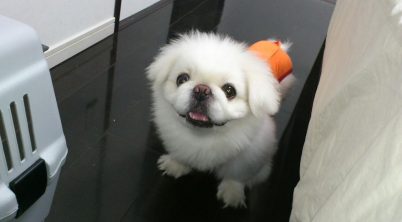The Pekingese and Pug are two distinctive breeds, both originating from China, where they have been esteemed by the upper echelons of society for centuries. The Pekingese, known for its flowing mane and lion-like physique, was historically revered within Chinese royalty. This breed’s appearance, characterized by a flat face and a dignified demeanor, has earned it the nickname “Lion Dog.” In contrast, the Pug possesses a compact frame, a charmingly wrinkled mug, and an expressive face. Recognized for its playful and loving nature, the Pug was also a favorite among Chinese emperors and has a significant history that dates back to around 200 B.C.
Despite physical similarities such as the brachycephalic (flat-faced) feature, Pekingese and Pugs are not direct relatives. The breeds developed in similar cultural contexts, which explains why they share some traits; however, they are distinct in their lineage and breed classification. The American Kennel Club, which has recognized the Pug since 1885 and the Pekingese since 1906, considers them separate breeds with their own set of standards and histories.
When there is a blend of the two breeds, it results in a crossbreed known as the Puginese, which combines characteristics from both the Pug and the Pekingese. The Puginese exhibits a mix of traits from its parent breeds, often leading to a unique and sometimes amusing appearance that includes their signature squashed face and endearing round eyes. They are usually small in stature, fitting for apartment living, and they carry the affectionate and playful qualities beloved in both Pekingese and Pugs.
Table of Contents
Pekingese Related to Pug?
The Pekingese and Pug are two distinct breeds, each with a rich history originating from China. Despite their separate breed classifications, they share some commonalities, including their cultural significance to Chinese royalty and their brachycephalic (flat-faced) features.
Historical Background
- Pekingese: Associated with Chinese royalty; known traditionally as “Lion Dogs.”
- Pug: Originated around 200 B.C.; favored by Chinese emperors.
Physical Characteristics
- Pekingese: Noted for their long, flowing coats and lion-like appearance.
- Pug: Recognizable by their compact, sturdy bodies and distinctive wrinkles.
The breeds are not directly related in a genetic or lineage context, as one might assume for closely connected family members. Nonetheless, the affectionate nature and small stature of the Pekingese and Pug have inspired crossbreeding, leading to a mix known as the Puginese, which combines traits of both parent breeds.
Puginese (Pug and Pekingese Mix) Characteristics
- Size: Typically weighs between 10 to 20 pounds; stands 8 to 12 inches at the shoulder.
- Appearance: Inherits the short muzzle which is a defining trait of both parent breeds.
Both parent breeds are recognized by the American Kennel Club, with the Pug gaining recognition in 1885 and the Pekingese in 1906. As with any brachycephalic dogs, prospective owners should be aware that this adorable appearance can lead to health challenges.
Origins and History
The Pekingese and Pug breeds both share a rich history rooted in ancient China. Their distinctive features and historical significance highlight their separate developments within Chinese canine lineage.
Chinese Lineage
The Pekingese, with its lion-like appearance, traces its history to the Tang Dynasty around the 8th century. They are known as “Lion Dogs” due to their resemblance to Chinese guardian lions. This breed was a symbol of royalty and was treasured by Chinese imperial families. On the other hand, Pugs also have roots in ancient China, with evidence of their existence dating as far back as 700 BC. These dogs were bred as companions for the Chinese elite, with a focus on their unique physiognomy marked by a short muzzle and a compact, muscular body.
Development of Dog Breeds
Over time, selective breeding practices shaped the Pekingese and Pug into the breeds known today. The American Kennel Club (AKC) officially recognized the Pekingese in 1906 and the Pug much earlier, in 1885.
- Pekingese:
- AKC Recognition Year: 1906
- Characteristics: Long, flowing coat; flat face
- Pugs:
- AKC Recognition Year: 1885
- Characteristics: Short coat; well-defined wrinkles on the face; curled tail
Both breeds have played significant roles in canine history and continue to be popular due to their unique appearances and charming dispositions. While they share a common geographic origin, their distinct development histories highlight the diversity of dog breeds that originated from ancient China.
Physical Characteristics
In discussing the physical characteristics of the Pekingese and Pug breeds, the focus is on their differences in size and appearance, as well as the grooming needs dictated by their various coat types.
Comparison of Size and Appearance
The Pekingese and Pug are both small in stature but exhibit distinctive physical features. The Pekingese stands at about 6-9 inches at the withers and weighs 7-14 pounds. They display a lion-like appearance with a flat face and large eyes. Conversely, the Pug is slightly more robust, typically weighing between 14 and 18 pounds and standing approximately 10-13 inches tall. Pugs have a compact, square body shape and feature a short, flat face with deep wrinkles.
Size Comparison:
| Breed | Height (inches) | Weight (pounds) |
|---|---|---|
| Pekingese | 6-9 | 7-14 |
| Pug | 10-13 | 14-18 |
Coat Variations and Grooming
The coat of a Pekingese is long, flowing, and requires regular grooming to prevent matting. They are known for substantial shedding, especially seasonally. Available in colors including gold, red, sable, and black, the Pekingese has a mane that resembles a lion’s, contributing to its nickname, “Lion Dog.”
The Pug’s coat is short, smooth, and glossy, with a less intensive grooming routine compared to the Pekingese. They are also shedders, with common colors being apricot-fawn and black. Pugs feature a characteristic black mask and ears, adding to their distinctive look. Regular brushing is recommended to manage shedding and keep the coat healthy.
Coat and Grooming Needs:
- Pekingese:
- Long, flowing coat
- Requires regular grooming
- High shedding
- Pug:
- Short, smooth coat
- Less intensive grooming needed
- Moderate shedding
Behavior and Temperament
Both the Pekingese and the Pug are known for their distinctive, affectionate nature and adaptability to family life, making them suitable companions in a variety of household settings. Recognizing each breed’s unique characteristics is key to understanding their behavior and temperament.
Personality Traits and Sociability
The Pekingese exhibits a regal dignity, often appearing independent and self-assured. It’s not uncommon for these dogs to demonstrate a discerning affection, reserving their attention for family members and trusted acquaintances. They possess a moderate energy level, are less inclined towards excessive activity, and are quite content with being lap dogs. Early socialization is crucial to encourage openness towards new people and environments.
Pugs, on the other hand, are renowned for their cheerful disposition. They are typically very sociable and friendly, eager to please their owners and quick to make friends. Pugs often possess a playful exuberance that endears them to both adults and children alike. They adapt well to apartment living due to their relatively low exercise requirements, but they still enjoy and benefit from regular playtime.
Interaction with Families and Pets
When it comes to family life, the Pekingese can be a devoted and affectionate companion, albeit with a streak of stubbornness. Gentle and consistent training methods work best with them, as they respond well to positive reinforcement. Pekingese may be cautious around children and typically prefer a quieter household.
In contrast, Pugs generally thrive in an environment with children and other pets. Their friendly and adaptable nature makes them excellent family pets. However, due to their gentle disposition, interactions with young children should be supervised to ensure play remains calm and safe. Pugs are also known to be good companions for other dogs and even cats, especially when raised together.
Health and Care
When considering the health and care of a Pekingese related to a Pug, it is crucial to be aware of breed-specific health concerns and to maintain a balanced diet and adequate exercise regimen that caters to their unique needs.
Common Health Issues
Brachycephalic Syndrome: Both Pekingese and Pug breeds are brachycephalic, meaning they have flat faces that can lead to respiratory problems. Owners should watch for symptoms like labored breathing and take care to prevent overexertion.
Hip Dysplasia and Patellar Luxation: These breeds may suffer from hip dysplasia, a malformation of the hip joint, and patellar luxation, where the kneecap dislocates. Regular vet checks can manage these conditions.
- Epilepsy: Canine epilepsy can be present, so monitoring for seizures is important for prompt treatment.
- Diabetes: Paying attention to signs of diabetes is necessary as it can occur in these breeds.
Diet and Exercise
Food: Their diet should consist of high-quality dog food suited to their age, size, and energy levels. Due to their risk of diabetes, their food intake should be monitored to prevent obesity.
- Exercise Needs: Although their exercise needs are moderate, regular activity is essential to prevent weight gain, which can exacerbate health problems.Exercise TypeFrequencyNotesShort WalksDailyIdeal for their small stature.Indoor PlaySeveral times a dayKeeps them stimulated.Controlled ExerciseAs advised by a vetTo prevent joint stress.
Careful attention to their health and care can mitigate common health issues and promote a fulfilling lifestyle for the Pekingese and Pug related breeds.

